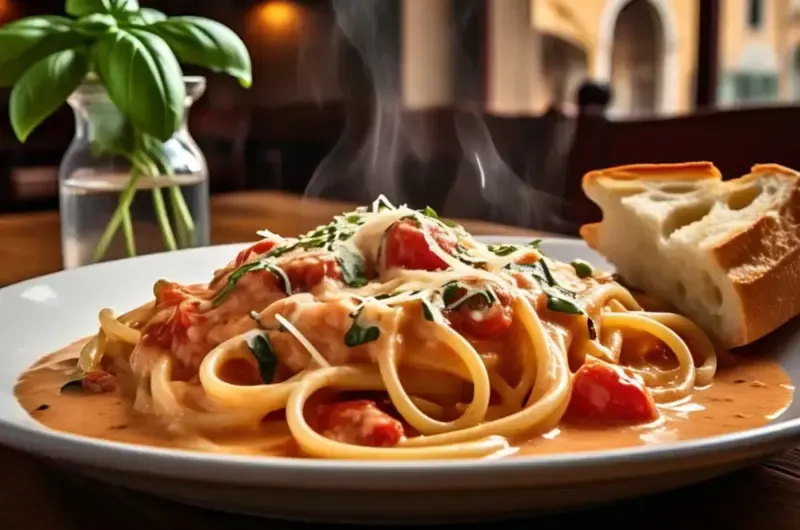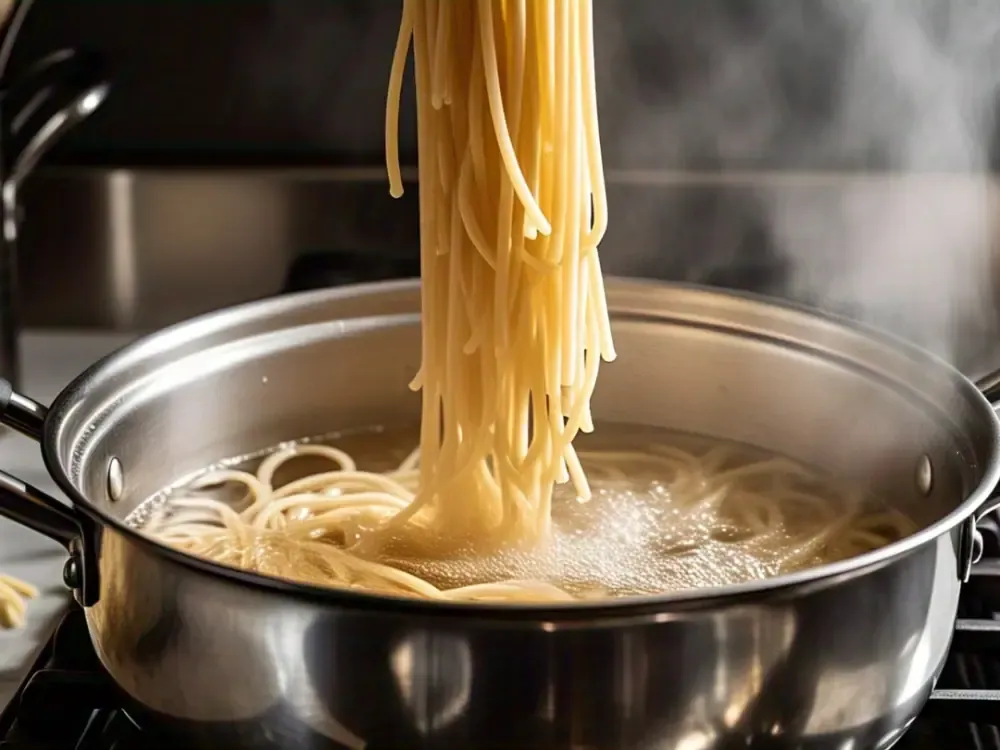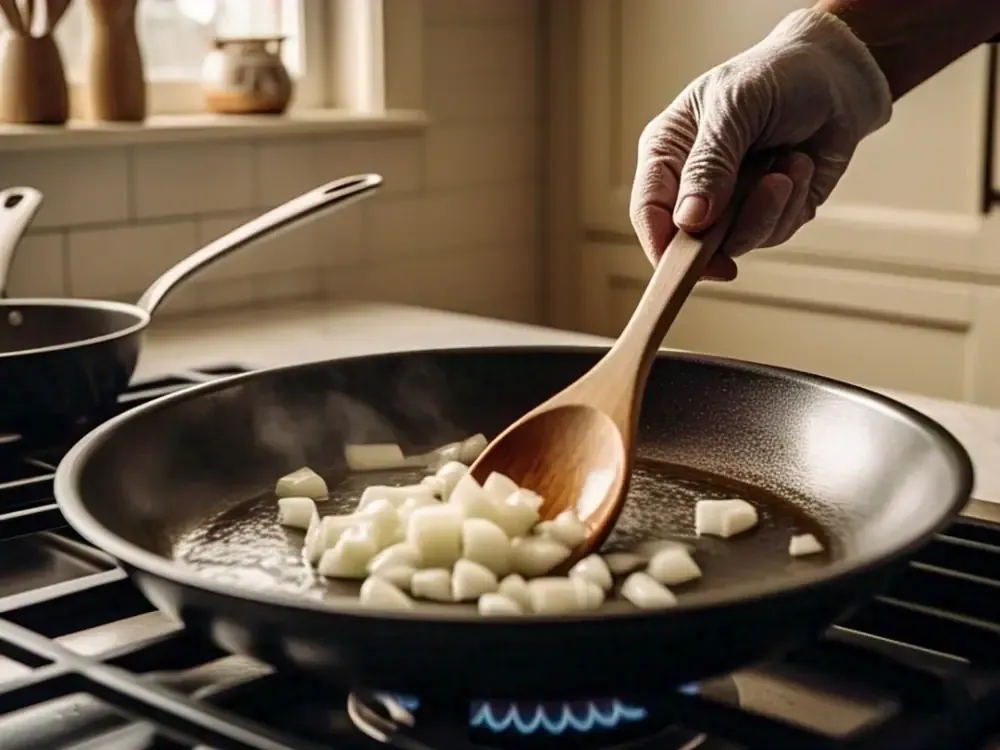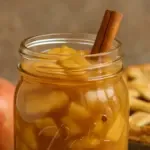The Best Fluffy Pancakes recipe you will fall in love with. Full of tips and tricks to help you make the best pancakes.
Long Squiggly Pasta Receipe
Imagine a bowl of long squiggly Pasta just ready to eat and a nice, cosy dinner with the aroma of tomatoes and basil filling the kitchen. Just that is this Creamy Tomato and Long Squiggly Pasta. A delicious long squiggly pasta with a small hole in the middle, bucatini hooks itself to a creamy tomato sauce.
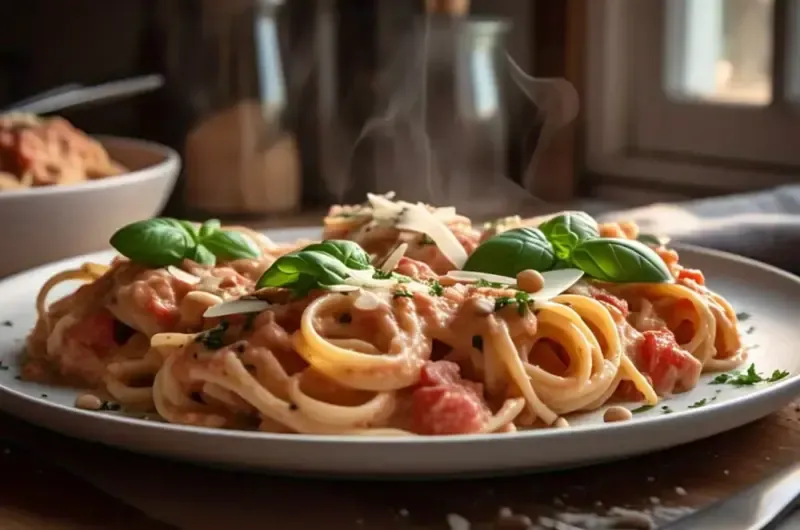
Perfect for dining with friends or lounging around the house, this is a cozy, delicious meal. Moreover, it’s quite simple to prepare, so anyone may create a dinner that seems to come from an Italian restaurant.
Why is it even more excellent? Anyone, from novice to experienced chefs, may quickly whip it up without worry thanks for simplicity. This long squiggly pasta dish offers a taste of comfort and delight in every mouthful, regardless of the temperature—a sunny afternoon or a cold evening—and brings the warmth and appeal of an Italian restaurant directly to the kitchen.
History of Long Squiggly Pasta
Eating long, squiggly pasta like bucatini is quite fun—it’s like spaghetti but with a fantastic, twirly form. Originating in Italy primarily in Rome, its name, bucatini, means “hole” from the small tunnel in every piece. Italy has long enjoyed this long squiggly pasta since the 1800s, most likely since it holds heavy sauces so well. Big platters of it would be shared during family dinners.
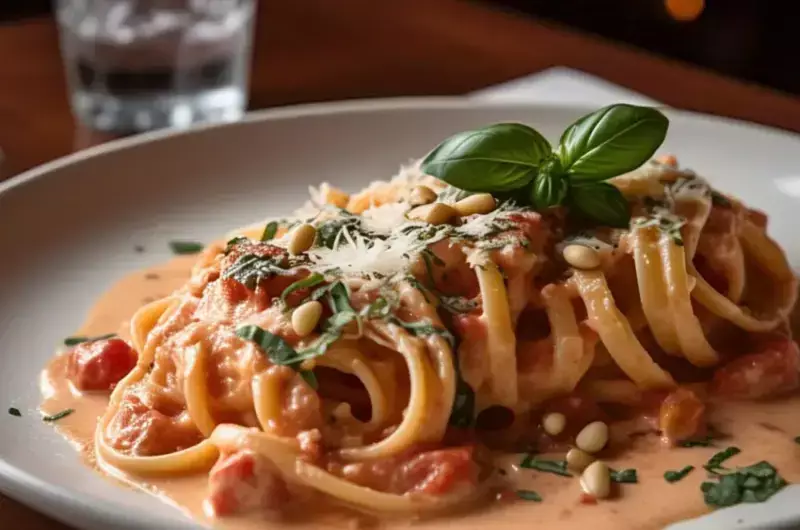
This dish’s sauce calls for tomatoes, which Italy first began to enjoy upon their arrival from the Americas in the 1500s. By the 1700s, tomatoes were a major feature in Naples and other locations blended with fresh basil from gardens.
Though it’s not quite traditional Italian, adding cream to tomato sauce gained popularity in Italian-American cuisine to create exceptionally rich and smooth sauces.
This recipe combines a contemporary, delicious sauce everyone likes with the traditional long squiggly pasta.
Details
4 Servings
10 Minutes
25 Minutes
520 Kcal per serving
Ingredients for Long Squiggly Pasta
These simple ingredients come together to create a delicious dish, with long squiggly pasta as the star, paired with a creamy, flavorful sauce.

Ingredients
- Bucatini (12 oz / 340g): Bucatini is the star long squiggly pasta in this dish, known for its long, twirly strands with a hollow center, like thick spaghetti with a tiny tube inside. Made from durum wheat, it has a chewy texture when cooked al dente and is found in most grocery stores with dried pasta. Its unique shape grabs and holds the creamy tomato sauce, ensuring every bite is packed with flavor. For pre-preparation, no steps are needed; just keep the package ready and measure 12 oz (about ¾ of a standard 1 lb box). Ensure a large pot is available for boiling. If bucatini isn’t available, spaghetti or linguine can be used, but they lack the hollow center that makes long squiggly pasta special.
- Olive Oil (2 tablespoons): Olive oil, preferably extra-virgin, is a cooking fat pressed from olives, adding a mild, fruity flavor to the dish. It’s used to sauté onions and garlic, creating the sauce’s flavorful base while adding richness without overpowering other ingredients. For pre-preparation, measure 2 tablespoons into a small bowl or keep the bottle handy with a measuring spoon. Vegetable oil can be substituted, but it has a neutral taste that’s less distinctive.
- Yellow Onion (1 small, finely diced): The sauce’s taste base is yellow onion, which cooked turns mild and sweet. When finely chopped, perhaps ½ cup for a small onion, its taste and richness meld easily into the dish. Peel the onion, chop off the ends, then dice in a shallow basin into tiny, even ¼-inch slices before cooking. Though they taste somewhat different, a white onion or shallot will work just as well.
- Garlic (2 cloves, minced): Garlic, a pungent bulb, adds a bold, warm, aromatic kick that complements the tomatoes in the sauce. Mincing it releases its oils for maximum flavor (two cloves make about 2 teaspoons minced). To prepare, peel the cloves by pressing them with the flat side of a knife to loosen the skin, then mince finely or use a garlic press, storing in a small bowl. If fresh garlic isn’t available, ¼ teaspoon of garlic powder can work, but it’s less vibrant.
- Crushed Tomatoes (1, 14.5 oz can): Crushed tomatoes are canned tomatoes mashed into a thick, smooth texture, providing the sauce’s rich, tangy tomato flavor (a 14.5 oz can is about 1¾ cups). Opt for no-salt-added versions to control seasoning. For pre-preparation, open the can and keep it ready, or pour into a bowl for easy pouring. Have a can opener handy if needed. Diced tomatoes (blended smooth) or fresh tomatoes (cooked down) can substitute if necessary.
- Heavy Cream (¾ cup): Heavy cream, a rich dairy product with 36-40% fat, makes the sauce creamy and smooth, balancing the tomatoes’ acidity with a velvety texture and mild sweetness. It’s found in the dairy section. Measure ¾ cup into a measuring cup or small bowl and keep refrigerated until needed to stay fresh. Half-and-half can be used for a less rich sauce, but milk may curdle and isn’t recommended.
- Grated Parmesan Cheese (½ cup, plus extra for serving): Parmesan is a hard, aged Italian cheese with a nutty, salty flavor, adding savory depth and slight thickness to the sauce when melted (½ cup is about 2 oz by weight). Freshly grated is ideal, but pre-grated works. Grate ½ cup (plus extra for serving) from a block using a fine grater, or measure pre-grated cheese, storing in a bowl. Pecorino Romano can substitute but is saltier; avoid processed Parmesan.
- Dried Oregano (1 teaspoon): Dried oregano is an earthy herb that enhances the Italian flavor profile, complementing tomatoes and basil. Found in the spice aisle, it’s best crushed in your hand before adding to release its aroma. Measure 1 teaspoon into a small bowl or have the spice jar ready, optionally crushing it lightly. Dried Italian seasoning or fresh oregano (1 tablespoon) can be used instead.
- Sugar (½ teaspoon, optional): Granulated sugar is used only if the canned tomatoes are too tangy, balancing their acidity for a smoother sauce. It’s not always needed, so taste the sauce first. Measure ½ teaspoon into a small bowl or keep a measuring spoon ready. Honey or a pinch of baking soda can also reduce acidity if preferred.
- Fresh Basil Leaves (10-12, roughly chopped): Fresh basil, with its soft green leaves and sweet, peppery taste, adds a bright, fresh flavor to the sauce, tying it to Italian tradition. Found in produce sections, chopping it releases its aroma. Rinse 10-12 leaves under cold water, pat dry with a paper towel, stack, roll, and roughly chop, storing in a small bowl. If unavailable, 2 teaspoons dried basil can work, but fresh is far better.
- Salt (to taste): Salt, either table or kosher, enhances all flavors in the sauce and pasta water, bringing out the dish’s full potential. Add it gradually to avoid over-salting; kosher salt is less intense. Keep a salt shaker or small bowl handy for adding to pasta water and sauce, adjusting while tasting. Sea salt is a similar alternative.
- Freshly Ground Black Pepper (to taste): Freshly ground black pepper, made from peppercorns, adds a sharp, spicy kick that balances the sauce’s richness. Freshly ground is best for bold flavor, but pre-ground works. Have a pepper grinder or small bowl of pre-ground pepper ready, adding while tasting. Pre-ground pepper is a fine substitute but less intense.
For Garnish
- Fresh Basil (2 tablespoons, thinly sliced): Fresh basil, sliced into thin strips (chiffonade), adds a fresh, colorful topping that enhances flavor and makes the dish look pretty. Thin slices release its aroma. Rinse 4-6 basil leaves, pat dry, stack, roll tightly, and slice thinly, storing in a small bowl or on a plate. Parsley can substitute for color but has a different taste.
- Toasted Pine Nuts (1 tablespoon, optional): Pine nuts are small, buttery nuts from pine cones, lightly toasted to add crunch and a nutty flavor that contrasts the creamy sauce. Found in baking aisles, they need toasting for 2-3 minutes in a dry pan until golden. Measure 1 tablespoon, toast in a small dry pan over medium heat, stirring, then cool and store in a small bowl. Slivered almonds or chopped walnuts, toasted, can be used instead.
Directions
Step 1: Cook the Long Squiggly Pasta
Boil water and cook bucatini until just right. Fill a big pot with water and heat it until it boils. Add a big pinch of salt to make the pasta taste better. Put in the bucatini (long squiggly pasta) and cook as the package says, about 8-10 minutes, until it’s soft but still a bit firm. Save 1 cup of the pasta water before draining, as it helps with the sauce later. Drain the long squiggly pasta and keep it aside.
Step 2: Prepare the Tomato Base
Cook onion and garlic, then add tomatoes. Put 2 tablespoons of olive oil in a large pan and heat it on medium. Add the diced onion and cook for 3-4 minutes, stirring sometimes, until it’s soft. Add the minced garlic and cook for 1 minute until it smells nice. Pour in the crushed tomatoes, add dried oregano, a pinch of salt, and black pepper. If the tomatoes are too tangy, add ½ teaspoon of sugar. Let the sauce cook for 8-10 minutes, stirring now and then, until it gets a bit thicker.
Step 3: Create the Creamy Sauce
Add cream and cheese for a smooth sauce. Turn the heat to low and slowly pour in the heavy cream, stirring to mix it with the tomato sauce. Cook for 2-3 minutes to blend the flavors. Add the grated Parmesan cheese and stir until it melts and the sauce is smooth. Mix in the chopped fresh basil leaves, keeping some for topping. If the sauce is too thick, add a little of the saved pasta water to make it silky. Taste and add more salt or pepper if needed.
Step 4: Combine Pasta and Sauce
Mix bucatini with sauce to coat well. Add the cooked bucatini (long squiggly pasta) to the pan with the sauce. Toss it gently with tongs so the sauce covers every twirly piece, letting the hole in the long squiggly pasta hold the sauce. If it’s too dry, add a bit more saved pasta water to help the sauce stick. Cook for 1-2 minutes on low heat so the long squiggly pasta soaks up the sauce’s taste.
Step 5: Serve the Dish
Plate and add toppings for a nice look. Split the long squiggly pasta into four plates or bowls, making sure each has lots of sauce. Top with thinly sliced fresh basil, a bit of extra Parmesan cheese, and toasted pine nuts for crunch, if wanted. Serve right away while it’s hot, with sides as suggested below.
Long Squiggly Pasta Receipe
Course: Main CourseCuisine: Italian-InspiredDifficulty: Easy4
servings10
minutes25
minutes520
kcalBucatini, a long squiggly pasta from Rome, has a hollow center and has been loved since the 1800s for holding sauces. Tomatoes, popular in Italy since the 1700s, pair with basil in this creamy sauce, a modern Italian-American twist.
Ingredients
- For the Pasta and Sauce:
12 oz (340g) bucatini (long squiggly pasta)
2 tablespoons olive oil
1 small yellow onion, finely diced
2 cloves garlic, minced
1 (14.5 oz) can crushed tomatoes
¾ cup heavy cream
½ cup grated Parmesan cheese, plus extra for serving
1 teaspoon dried oregano
½ teaspoon sugar (optional, to make tomatoes less tangy)
10-12 fresh basil leaves, roughly chopped
Salt, to taste
Freshly ground black pepper, to taste
- For Garnish:
2 tablespoons fresh basil, thinly sliced
1 tablespoon toasted pine nuts (optional, for crunch)
Directions
- Fill a large pot with water, bring to a boil, add a pinch of salt, and cook bucatini (long squiggly pasta) for 8-10 minutes until al dente, reserving 1 cup of pasta water before draining.

- Heat 2 tablespoons of olive oil in a large pan over medium heat and cook diced onion for 3-4 minutes until soft.

- Add minced garlic to the pan and cook for 1 minute until fragrant.
- Pour in crushed tomatoes, add dried oregano, a pinch of salt, black pepper, and ½ teaspoon sugar (if tomatoes are tangy), then simmer for 8-10 minutes until thickened.
- Lower the heat, pour in ¾ cup heavy cream, and cook for 2-3 minutes to blend flavors.
- Stir in ½ cup grated Parmesan cheese until melted, add chopped basil, and adjust sauce consistency with reserved pasta water if too thick.
- Add cooked bucatini to the sauce, toss gently to coat evenly, and cook for 1-2 minutes on low heat.
- Divide pasta into 4 plates, top with sliced basil, extra Parmesan, and toasted pine nuts (if using), and serve immediately.
Tips for Serving
- Side: Pair with arugula salad or crusty bread.
- Drinks: Chianti, Chardonnay, or lemon sparkling water.
- Look: Twirl long squiggly pasta into nests for a fancy plate.
- Extras: Add sausage, scallops, or veggies like zucchini.
- Leftovers: Store in fridge 3 days, reheat with cream.
- Kids: Blend sauce smooth for picky eaters.
